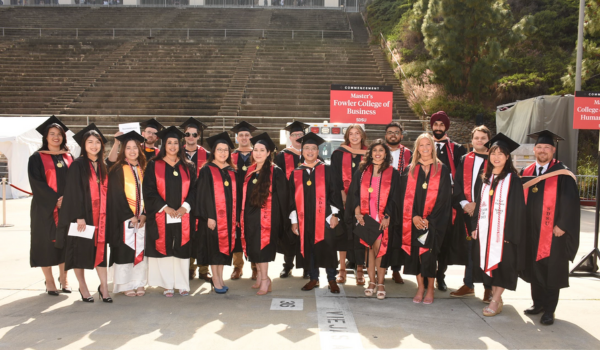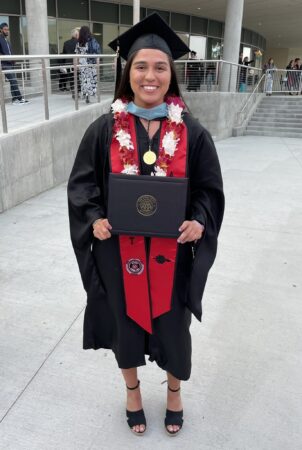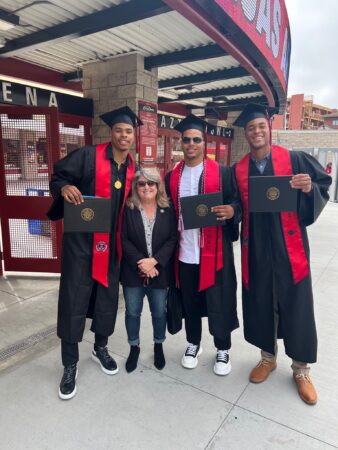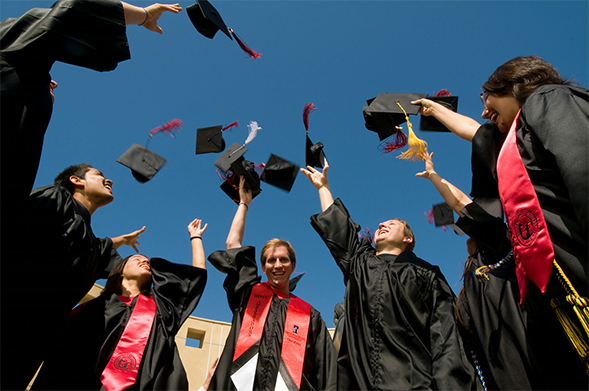NCAA should make the COVID year of eligibility permanent

SDSU graduation in 2019. (Credit: Trip Advisor)

“Open the envelope when you get back to your dorm,” a midwestern coach told his players in the 1980s. A booster needed help moving some furniture. When the coach-arranged side hustle was complete, each athlete was given a white envelope as compensation for their work.
Back home, out of the public eye, the players opened the envelopes to see their ill-gotten gain of $50. This true anecdote testifies to the silliness of the former NCAA rules and the lengths schools went to go around them.
These paltry sums pail compared to the amounts that switched hands to pay for an athlete to play at some institutions. The UCLA Bruins under John Wooden, for example, were financed by booster Sam Gilbert. USC’s football dynasty, led by Pete Carroll, ended with a vacated Heisman Trophy and National Title.
Some have pointed to stories like these to dismiss the novelty of the current NIL and one-time transfer rules, suggesting what was done under the table in the past is simply occurring out in the open now. What this argument misses is the “pay-to-play” aspect of college sports was always on the periphery. Today, it holds center stage.
For academics to reclaim its primary spot in the imagination of the country, the NCAA should adopt a rule change. It needs to make the extra COVID year permanent. Instead of giving students five years to play four, they should grant athletes six years to play five.
“The ‘win’ for the academic services staff, and it goes all the way up to our athletic director, John David Wicker, is (degree) completion,” Bobby Smitheran, the Executive Associate Athletic Director of Student-Athlete Academic Support Services at SDSU told EVT. “Our championship is student-athletes earning their degree, and we all take a lot of pride in that because that commitment to being a student-athlete at the Division I level is very significant.”

Shift in Mindset
Smitheran explained that unofficially the NCAA defined academic success as a player earning a bachelor’s degree. Anything beyond that was viewed as “a cherry on top.” This perspective is reflected in The NCAA’s Division I Degree Completion Award Program.
It has awarded over $30 million to 2,900 DI athletes since it was founded in 1989, according to the program’s webpage. Only former scholarship athletes, who have exhausted their five years of eligibility without earning a bachelor’s degree, are eligible to apply.
Like many of the bylaws of college athletics governing body, this mindset was shaped during a time when a bachelor’s degree was a ticket to the upper middle class. Today, a graduate degree is needed for that distinction. The US Bureau of Labor Statistics said that in 2022, someone with a master’s degree earned $12,480 a year more than someone with only a bachelor’s degree. Over a 40-year career, that is a $499,200 difference.
“That (extra) year helps them have more time to get to the league and pursue their dreams,” Deshawn Mccuin said on Episode 70 of The SDSU Football Podcast. “But it also helps them have a higher education to get a higher paying job or get to work wherever you want around the country. That extra year benefits a lot of people, me included.”
Mccuin transferred from TCU to SDSU, having already earned a bachelor’s degree. He plans to pursue a Sports Marketing MBA, an 18-month program. Due to the extra year granted by the NCAA due to COVID, Mccuin can earn the degree before his football eligibility expires.
Providing players with better support
Academic aspirations for any student are personal. Under the current system, some athletes are only interested in staying eligible to play their sport; others reduce the school load to compensate for the demands of competing with an eye on completing their bachelor’s degree. For a small group, they work to complete their master’s degree in the five years they are on scholarship.
No matter what motivation students arrive on campus with, research has shown the single greatest reason athletes enroll in graduate-level classes is because of the schedule they keep to compete in their sport. “Engaging College Athletes in & Through Graduate Study,” an article in the Journal of Issues in Intercollegiate Athletics, concluded, “the NCAA rules that allowed them to pursue graduate degrees, not more individual enabling factors, meant that they ought to do so.”
With the extra Covid year, Smitheran said, there has been an uptick in student-athletes aiming for a master’s degree at SDSU. Even more would have taken advantage of this opportunity, except the addition of the extra year was not known when the student-athletes formed their academic plans. Here is another reason the NCAA should change the rule. A graduate degree would be a powerful carrot encouraging athletes to focus more on the classroom during their early years on campus.

At SDSU, approximately 450 student-athletes are divided between six academic advisors. These skilled professionals bring decades of experience to their roles. Beginning when an athlete takes an unofficial visit and often continuing after they have exhausted their eligibility, the advisors’ aim is to use their expertise of what SDSU offers and match it to the goals of the student-athletes. Armed with an extra year of eligibility, these artists could open up great avenues for their students.
“We really have an intrusive academic advisement model in terms of we really get to know our student-athletes on an interpersonal level so that we can understand their strengths and weaknesses, what their goals and desires are, and then try to help them achieve whatever those stated goals are,” Smitheran explained.
Among young people, there is a mental health crisis. Extending the year of eligibility would allow the athletes to enjoy the support of the academic advisers a little longer. The same is true for the athletic trainers and strength and conditioning staff. The more time they spend with a person, the greater their expertise ties to what that individual needs.
Another reason to transfer aside from NIL money
Money is the main reason players transfer between programs, giving the impression that major college sports is amateur in name only. Putting a master’s degree in reach by adding a year of eligibility would give athletes another reason to select a new school other than NIL opportunities.
“We’ve definitely seen an uptick of (student-athletes earning a master’s degree) because of the creation of the transfer portal,” Smitheran explained. “That really created an opportunity for student-athletes to take advantage of their season of eligibility, maybe at another institution with an undergraduate degree in hand. Certainly, we saw some instances of student-athletes who were really academically motivated and saw it as an opportunity to earn a graduate degree from a specific institution, who was maybe a leader in their certain fields from a graduate studies perspective.”

The chance to be a true scholar in a particular field is an enticing opportunity. Mccuin’s decision to come to SDSU was made easier because, as recently as 2017, the Sports Marketing MBA at SDSU was ranked as the fourth best globally. The chance for a world-class education in an area of Mccuin’s interest gave the Aztecs a leg-up in his recruitment.
From a public relations standpoint, conversations about transfers switching schools to pursue specific master’s programs are precisely the messages needed to reestablish major college athletics as amateur sports. The prestige of a graduate degree still holds sway in society and will encourage some players to put off their professional aspirations.
“The second part (of returning to SDSU) was getting my master’s degree,” Aztec center Nathan Mensah told EVT’s Kevin Sandoval last week. “It’s something that I’ve always wanted to do. Getting your master’s degree does not make you smarter than anyone, but it puts you among a different group or class, so that’s one thing that also played a role for me coming back.”
Leveling the Playing Field
Cinderellas and underdogs are what make sports great. The professional level has grown stale because the same teams, year after year, are the only ones capable of winning titles. NIL and the one-transfer rule threaten to make the college game just as bland.
The handful of teams with lucrative NIL collectives are already turning the rest of the schools into de facto minor league teams. Unless something changes, this competitive imbalance will only grow.
Adding an extra year with a chance to earn a graduate degree will make this reality less decisive. A fringe NFL prospect six years removed from high school can compete with a more talented but younger rival.
The landscape of college athletics is experiencing tumultuous change. As a way to calm the storm and keep its identity, the NCAA should adopt a rule change. They should make the extra COVID year of eligibility permanent.
My earliest sport’s memory involve tailgating at the Murph, running down the circular exit ramps, and seeing the Padres, Chargers and Aztecs play. As a second generation Aztec, I am passionate about all things SDSU. Other interests include raising my four children, being a great husband and teaching high school.